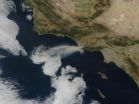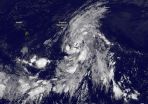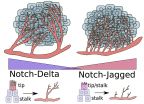(Press-News.org) WASHINGTON, D.C. - Southern Californians and writers love to blame the hot, dry Santa Ana winds for tense, ugly moods, and the winds have long been associated with destructive wildfires.
Now, a new study finds that on occasion, the winds have an accomplice with respect to fires, at least: Natural atmospheric events known as stratospheric intrusions, which bring extremely dry air from the upper atmosphere down to the surface, adding to the fire danger effects of the Santa Anas, and exacerbating some air pollution episodes.
The findings suggest that forecast models with the capacity to predict stratospheric intrusions may provide valuable lead time for agencies to issue air quality alerts and fire weather warnings, or to reallocate firefighting resources before these extreme events occur.
"The atmosphere could give us an early warning for some wildfires," said Andrew Langford, a research chemist at the National Oceanic and Atmospheric Administration's (NOAA) Earth System Research Laboratory in Boulder, Colorado, and lead author of the study.
Researchers at NOAA's National Environmental Satellite, Data, and Information Service (NESDIS) and the Cooperative Institute for Research in Environmental Sciences (CIRES) at CU-Boulder coauthored the work, which has been accepted for publication in Geophysical Research Letters, a journal of the American Geophysical Union.
The authors took a detailed look at the May 2013 "Springs Fire" that burned 100 square kilometers (25,000 acres) about 75 kilometers (50 miles) northwest of Los Angeles. The researchers used a NOAA forecast model that incorporates satellite observations of ozone, wind data, and other atmospheric information to detect the occurrence of the intrusions.
The analysis showed that in the early hours before the Springs Fire, a tongue of air characteristic of the stratosphere--extremely dry and very high in ozone from the stratosphere's ozone layer--reached to the surface in southern California and extended as far south as Baja California.
The researchers found that ground-based monitoring stations near the fire's origin also confirmed the telltale signs of the intrusion right before the fire broke out: A large drop in relative humidity and a rise in ozone. As the day went on, a combination of factors accelerated the fire: Low humidity, persistent high winds, dry condition of the grasses and other vegetation, clear skies and bright sunlight, and very warm surface temperatures. A few days later, cloudy skies, a drop in temperature, a shift in winds, and widespread rainfall helped extinguish the fire.
The stratospheric intrusion also had another downside during the Springs Fire: It added ozone from the upper atmosphere to the urban and fire-related pollution produced in the lower atmosphere. On the second and third days of the fire, this helped to push levels of ozone--which can harm people's lungs and damage crops--over the federal ozone limit at 24 monitoring sites across southern California. Monitors as far away as Las Vegas also saw a spike in ozone on the third day of the fire. The observed exceedances of the ozone standard were unusual for the region for that time period, suggesting that the stratospheric intrusions were a contributing factor.
"Stratospheric intrusions are double trouble for Southern California," said Langford. "We knew that the intrusions can add to surface ozone pollution. Now we know that they also can contribute to the fire danger, particularly during La Niña years when deep intrusions are more frequent, as recently shown by our NOAA colleagues at the Geophysical Fluid Dynamics Laboratory. The good news is that with models and observations, we can get an early warning from the atmosphere in some cases."
The authors note that stratospheric intrusions have previously been implicated in the explosive development of wildland fires in New Jersey and Michigan, but have not previously been connected to fires in southern California or to the Santa Ana winds. The frequent occurrence of stratospheric intrusions above the west coast during the fall, winter, and spring suggests that similar circumstances may have played a role in other major southern California fires, including the series of destructive fires that burned more than 3,000 square kilometers (more than 800,000 acres) in October of 2003, and burned about 4,000 square kilometers (nearly a million acres) in October of 2007, say the authors.
INFORMATION:
The American Geophysical Union is dedicated to advancing the Earth and space sciences for the benefit of humanity through its scholarly publications, conferences, and outreach programs. AGU is a not-for-profit, professional, scientific organization representing more than 60,000 members in 139 countries. Join the conversation on Facebook, Twitter, YouTube, and our other social media channels.
CIRES is a partnership of NOAA and CU-Boulder.
AGU Contact:
Nanci Bompey
+1 (202) 777-7524
nbompey@agu.org
CIRES Contact:
Katy Human
+1 (303) 735-0196
Kathleen.human@colorado.edu
NOAA Contact:
Monica Allen
+1 (301) 734-1123
Monica.Allen@noaa.gov
AROUND half of all breast cancer patients could one day benefit from having the cheap and widely-available female hormone progesterone added to their treatment, according to Cancer Research UK funded research published in Nature today (Thursday)*.
Tumours fuelled by the female hormone oestrogen are treated with drugs like tamoxifen to block oestrogen receptors, which cause cancer cells to grow.
Women whose tumours have progesterone receptors as well are known to have a better outlook. But for decades scientists have been unable to pinpoint why.
Scientists at Cancer ...
From a Glacier's Perspective
Big Four glacier & ice caves, WA: a short future?
Early summer melting led to the collapse of Washington ice caves, the death of one person, and the injury of five others. Mauri Pelto asks questions about the future of Washington's Big Four glacier on his blog From a Glacier's Perspective.
Eos.org
Learning geoscience by doing geoscience
A pilot project helps teachers bring scientific practice into the classroom.
New research papers
Response of the Amazon carbon balance to the 2010 drought derived with CarbonTracker South America, ...
Researchers have developed a new approach for better integrating medical devices with biological systems. The researchers, led by Bozhi Tian, assistant professor in chemistry at the University of Chicago, have developed the first skeleton-like silicon spicules ever prepared via chemical processes.
"Using bone formation as a guide, the Tian group has developed a synthetic material from silicon that shows potential for improving interaction between soft tissue and hard materials," said Joe Akkara, a program director in the National Science Foundation materials research ...
Tropical Depression 4E formed in the Eastern Pacific and crossed the 140 West longitude line as of the 0300 UTC time, which brought it into the Central Pacific Ocean. NOAA's GOES-West satellite captured an infrared image of the depression at 0900 UTC (5 a.m. EDT) on July 8 that showed the large storm in the Central Pacific.
At 8 p.m. PDT/11 p.m. EDT on July 7, (0300 UTC on July 8), the center of newly formed Tropical Depression Four-E was located near latitude 15.4 North, longitude 140.2 West. The depression was moving toward the west-northwest near 17 mph (28 kph) and ...
Rice University researchers have built a simulation to show how cancerous tumors manipulate blood-vessel growth for their own benefit.
Like all cells, those in tumors need access to the body's fine network of blood vessels to bring them oxygen and carry away waste. Tumors have learned to game the process called angiogenesis in which new vessels sprout from existing ones, like branches from a tree.
But some details have been hidden until now.
The ability to stop tumors through anti-angiogenesis is one goal of cancer therapy. The new work by scientists at Rice's Center ...
July 8, 2015 - A recent CDC report calls into question the widely reported belief that Black fathers are more absent in their children's lives than White fathers - showing that while more Black fathers live apart from their children, they are just as involved with their children as members of other racial groups in the same living situations. So why is it that messages about Black absentee fathers, such as Obama's 2008 Father's Day address, are so pervasive in society?
A new paper, published today in Social Psychological and Personality Science, suggests that such messages ...
CAMBRIDGE, Mass--When you spill a bit of water onto a tabletop, the puddle spreads -- and then stops, leaving a well-defined area of water with a sharp boundary.
There's just one problem: The formulas scientists use to describe such a fluid flow say that the water should just keep spreading endlessly. Everyone knows that's not the case -- but why?
This mystery has now been solved by researchers at MIT -- and while this phenomenon might seem trivial, the finding's ramifications could be significant: Understanding such flowing fluids is essential for processes from the ...
CHICAGO (July 8, 2015): Work hour restrictions for resident physicians, revised nationally four years ago largely to protect patients against physician trainees' fatigue-related errors, have not had the desired effect of lowering postoperative complication rates in several common surgical specialties, according to new study results. The study was published as an "article in press" on the Journal of the American College of Surgeons website in advance of print publication later this year.
There was no significant difference in measured surgical patient outcomes between ...
Natural killer cells of the immune system can fend off malignant lymphoma cells and thus are considered a promising therapeutic approach. However, in the direct vicinity of the tumor they lose their effect. Scientists of Helmholtz Zentrum München have now elucidated which mechanisms block the natural killer cells and how this blockade could be lifted. The results were recently published in the European Journal of Immunology.
Natural killer cells (NK cells) are part of the immune system and provide an innate immunity against exogenous and altered endogenous structures. ...
BLOOMINGTON, Ind. -- The number of women across the globe filing patents with the U.S. Patent and Trade Office over the past 40 years has risen fastest within academia compared to all other sectors of the innovation economy, according to a new study from Indiana University.
The analysis, which examined 4.6 million utility patents issued from 1976 to 2013, was led by Cassidy R. Sugimoto, an associate professor of informatics at the School of Informatics and Computing at IU Bloomington.
The results of "The Academic Advantage: Gender Disparities in Patenting" are reported ...



